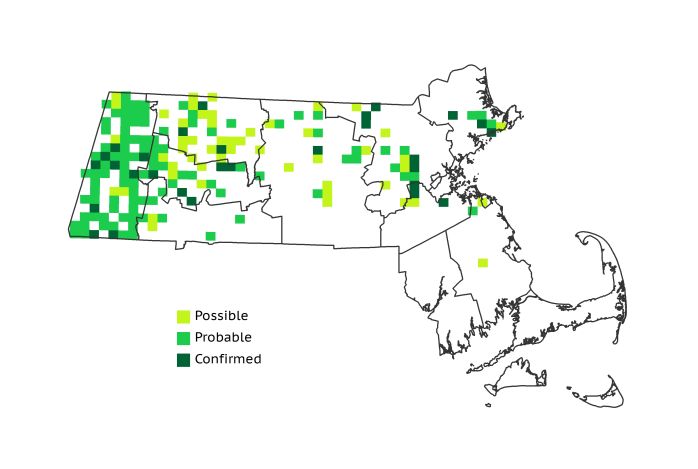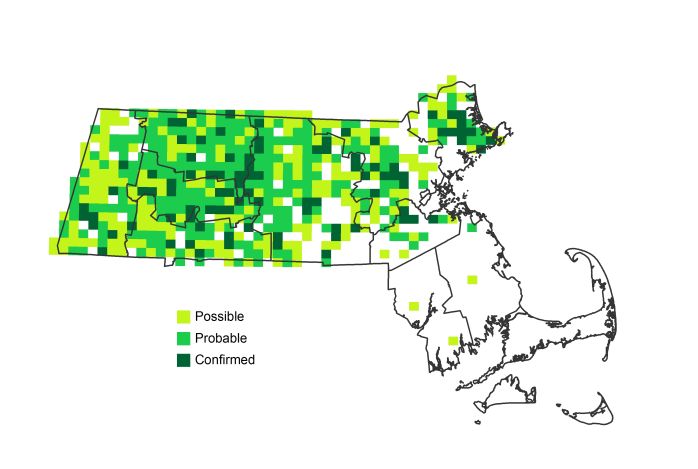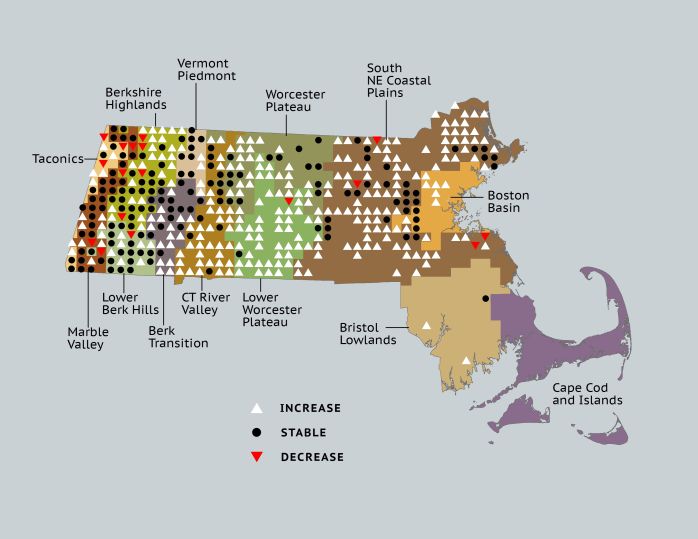Find a Bird
Pileated Woodpecker
Dryocopus pileatus

Widespread and strongly increasing

“Heh heh heh HAA ha! Heh heh heh HAA ha! Hahahahahaha!” – Woody Woodpecker
The appearance of the famed screwball cartoon icon, particularly his prominent red crest, might have been inspired by a Pileated Woodpecker. This largest and most striking of Massachusetts’ breeding woodpecker species is also the most reclusive, historically preferring to dwell in areas of old growth and heavy timber. Although they were often victims of hunting pressure and long-term landscape changes, Pileated Woodpeckers recovered well. They are now facing new challenges in Massachusetts’ ever-changing landscape, but they seem to be adapting to life in our wooded suburbs.
Historic Status
This largest living North American woodpecker suffered extensive habitat loss when Europeans first began to settle the region. Without large trees, there could be no large woodpeckers, and as such the Pileated Woodpecker declined during the nineteenth century from “not uncommon in the woodlands of Massachusetts” (Peabody 1839) to “nearly or quite extirpated from most parts of the state” (Allen 1878). As Massachusetts farmers started abandoning land in favor of more fertile grounds to the west or more urban lifestyles in the late 1800s, forests gradually regenerated, and the woodpeckers returned. By the late 1920s Edward Howe Forbush stated that it was “now less rare in Massachusetts than it was ten years ago” (Forbush 1927). He was witnessing the nationwide rebound of the species right before his eyes.
Atlas 1 Distribution
The return of forest cover to Massachusetts brought with it increasing numbers of Pileated Woodpeckers. Pileateds were most commonly encountered in the far western parts of the state, where large intact areas of mature forest still existed. In the Connecticut River Valley, these impressive woodpeckers showed a primarily northern distribution, and they were similarly more concentrated in the Worcester Plateau than in the more southern Lower Worcester Plateau. The spread of shade trees in the Boston Basin and wooded parklands within the Coastal Plains also attracted small concentrations of breeding Pileated Woodpeckers, though the species remained quite local overall in the eastern half of the state. The southeast was long devoid of breeding Pileateds, save for a single Possible block in the Bristol/Narragansett Lowlands.
Atlas 2 Distribution and Change
Following closely on the heels of maturing Massachusetts forests, and in good company with other woodpeckers, Pileated Woodpeckers had expanded their distribution considerably by the time of Atlas 2. Pileated Woodpeckers did not decline in any ecoregion in the Commonwealth, and their range greatly increased from its 1979 level in many areas. In the western ecoregions, the species transitioned from being widespread to becoming nearly ubiquitous, particularly in the Berkshire Transition and Vermont Piedmont regions. The Connecticut River Valley and Worcester Plateau regions experienced rapid expansion of Pileated Woodpeckers, and the species can now be found in nearly all corners of those regions. The Coastal Plains and even the Boston Basin also demonstrated considerable Pileated Woodpecker expansion, bringing our most impressive woodpecker out of remote woods and into city parks and backyards. During Atlas 2 Pileated Woodpeckers remained rare in the Bristol/Narragansett Lowlands and absent from Cape Cod and the Islands.
Atlas 1 Map

Atlas 2 Map

Atlas Change Map

Ecoregion Data
Atlas 1 | Atlas 2 | Change | ||||||
Ecoregion | # Blocks | % Blocks | % of Range | # Blocks | % Blocks | % of Range | Change in # Blocks | Change in % Blocks |
Taconic Mountains | 9 | 56.3 | 5.0 | 18 | 72.0 | 3.2 | 3 | 20.0 |
Marble Valleys/Housatonic Valley | 29 | 74.4 | 16.1 | 34 | 87.2 | 6.1 | 5 | 12.8 |
Berkshire Highlands | 27 | 49.1 | 15.0 | 49 | 89.1 | 8.8 | 20 | 37.7 |
Lower Berkshire Hills | 18 | 64.3 | 10.0 | 26 | 83.9 | 4.7 | 7 | 25.9 |
Vermont Piedmont | 10 | 58.8 | 5.6 | 17 | 100.0 | 3.1 | 4 | 33.3 |
Berkshire Transition | 15 | 39.5 | 8.3 | 38 | 95.0 | 6.8 | 16 | 51.6 |
Connecticut River Valley | 12 | 21.4 | 6.7 | 54 | 83.1 | 9.7 | 33 | 68.8 |
Worcester Plateau | 18 | 23.1 | 10.0 | 85 | 96.6 | 15.3 | 31 | 64.6 |
Lower Worcester Plateau | 5 | 6.8 | 2.8 | 69 | 86.3 | 12.4 | 44 | 81.5 |
S. New England Coastal Plains and Hills | 33 | 12.2 | 18.3 | 151 | 53.4 | 27.2 | 90 | 39.8 |
Boston Basin | 3 | 5.4 | 1.7 | 11 | 19.6 | 2.0 | 8 | 14.5 |
Bristol and Narragansett Lowlands | 1 | 0.9 | 0.6 | 3 | 2.6 | 0.5 | 2 | 2.0 |
Cape Cod and Islands | 0 | 0.0 | 0.0 | 0 | 0.0 | 0.0 | 0 | 0.0 |
Statewide Total | 180 | 18.6 | 100.0 | 555 | 53.5 | 100.0 | 263 | 31.7 |
Notes
In accordance with Atlas increases, the Pileated Woodpecker shows significant increasing Breeding Bird Survey trends in Massachusetts, the New England/Mid-Atlantic Region, and in the Eastern US overall.



